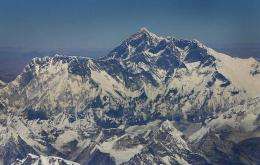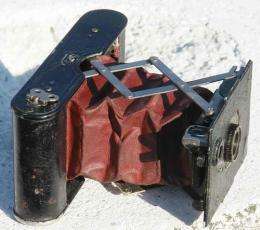January 29, 2010 report
Search for frozen camera may reveal who climbed Everest first

(�鶹��ԺOrg.com) -- An Everest historian believes he may have pinpointed the last resting place of mountaineer Andrew Irvine, who died on a mission to climb Mount Everest in 1924, almost 30 years before the successful climb of Sir Edmund Hillary and Tenzing Norgay. No one knows whether or not Irvine and his companion George Mallory ever reached the summit, but the remains of Irvine, and particularly the camera he was carrying, may be able to solve the mystery.
Mallory and Irvine left their camp a kilometer beneath the summit on June 8, 1924, and were never seen again. Several expeditions have gone to Everest in search of the missing pair, and Mallory’s body was found in 1999, but there has been no sign of Irvine and the Vest Pocket Kodak camera he was apparently carrying. If the camera can be found, it may reveal whether the mountaineers died on their way up to the summit, or on their way down.
Historian Tom Holzel pored over maps and photographs of the north face of Everest for decades looking for clues. Now he believes a high-resolution picture reveals Irvine’s remains, and with a group of five colleagues has begun preparing for an expedition to investigate, possibly as early as spring 2010.
Holzel and his group, dubbed the Andrew Irvine Search Committee, say a set of photographs of an area on the north face 900 meters wide and called the “yellow band” showed up an oblong object 1.8 meters long when the group used a computer to morph two images together. One of the photographs was taken by mountaineer Wynn Harris in 1933 while searching for the missing duo, and the other was a high-resolution aerial photograph taken from 13,500 meters in 1984. The aerial image is an orthophotographic image, which means it is corrected to provide an accurate representation of the surface, and can be used to measure distances.
Harris found an ice ax he believed belonged to Irvine, and marked an “x” on the photograph to mark its location. The comparison of this photograph with the aerial image suggests the location of the ax marked on the photo is out by around 55 meters.

To examine the photographs in more detail Holzel and two other members of the group bought a digital camera and a powerful microscope and took sequential digital microphotographs of the aerial photograph at 60 x normal resolution. They then used a computer to compile the images into a high-resolution panoramic view of the north face’s yellow band. This view showed the most likely route Mallory and Irvine had taken. They then used the microscope to look for body-sized anomalies on the probable route, and found a likely target.
If the anomaly turns out to be Irvine’s body, and if the frozen camera is found and film inside it can be developed, and if it contains an image from the summit, the history of who reached the summit first may have to be re-written. However, Hillary and Norgay will always remain the first to make a successful expedition to the summit and back, since they returned to tell the tale.
More information:
--
--
-- camera
via
© 2010 �鶹��ԺOrg.com

















